A Whale of a Good Time
Mystic Section of Stonington (Google Maps Location)
August 11, 2007
This page is… embarrassing. The Seaport is, to me, Connecticut’s premier attraction. I’m writing this statement 13 years after writing this page, and the only reason I keep it intact is so you all can laugh at me. I will revisit and will make things right.
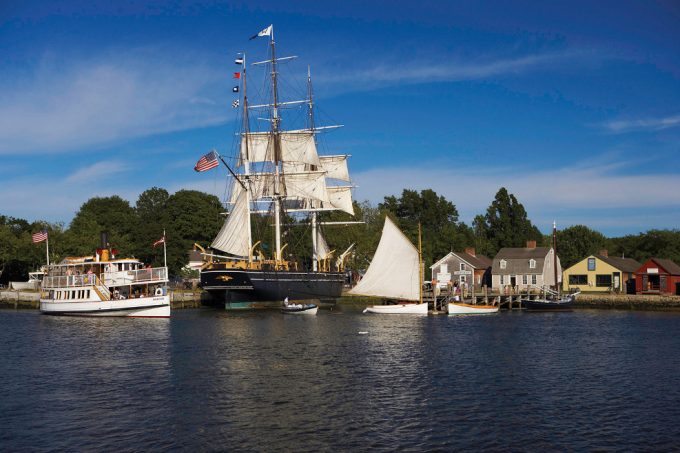
Before we get going with the August 2007 visit report below, I want to take you back in time – back to 2006, when I thought it would be a good idea to visit the Mystic Seaport… In December. With 9 month old. This is an excerpt from an article titled “Mystic Seaport? More Like Mystic See Nothin'” from my old pre-CTMQ blog:
…We loaded up the car, made a few stops around town and then hit the open highway. The forecast was lower 50’s and bright sunshine. Hoang and I waffled on whether we should drive all the way out to Mystic or should we just go to a closer museum, but decided against that and we drove onward to the Long Island Sound.
We made good time and even felt compelled to check out the Mystic River scenic overlook on I-95. I have no idea how many scenic overlooks there are along the length of 95, but I’d guess very few. I only hope the others are better than this:
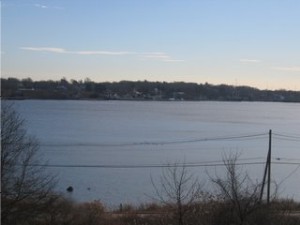
At least the sign was cool, and got us excited for our big day at the historic Mystic Seaport.
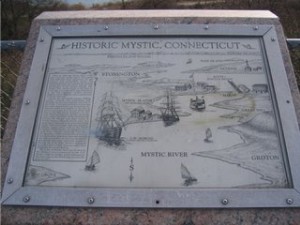
We exited the highway and made the 2 mile drive across Mystic in a couple minutes. This is notable because it takes an hour in the summer. We parked, fed Damian, opened the door to get the stroller and – holy cow that’s some serious wind.
Maybe just an anomaly. WHOOOOOSH!
Dang. Nope. WHOOOOOSH! Yes, while it was perfectly placid back at our suburban home, it turns out it’s a bit windier down at the coast. And a lot colder too. Ah well, Damian is tough and we had plenty of blankets and WHOOOOOOSH! now Hoang was cold. We walked to the welcoming sign and maintained our optimism:
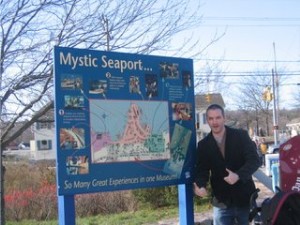
(Note on the map above, the whole Seaport is 17 acres or so, all of it outside more-or-less, and all of it fully exposed to the cove. WHOOOOSH! We crossed the street and braced ourselves for what would be a lovely day of sightseeing and learning about the storied past of Mystic, the shipping and whaling industries, the scrimshaw, WHOOOOOSH! It was going to be great! (A really cold) WHOOOOOSH!
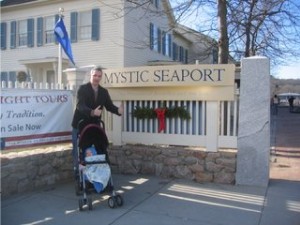
Yay! (Just before a 30 mph blast of cold wind)
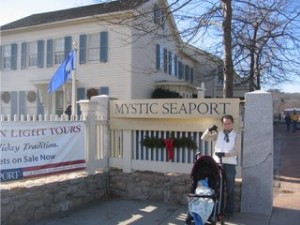
Nay! (Just after said blast of cold wind)
We immediately turned around, got in the car, and headed to Essex for a second visit to the Connecticut River Museum. We’ll be back Seaport, oh, we’ll be back. You don’t have to be an – ahem – “Mystic” to predict that.
![]()
Alas – flash forward to August of 2007 and here we were again! At the tail end of our little vacation out to Narragansett, Rhode Island, we had planned on stopping at the Seaport on our way home. Our only probelm was that Damian destroyed our little digital camera at the beach – and a museum isn’t a CTMQ museum if there are no pictures…
But we soldiered on with the hope that the camera would miraculously fix itself. We drove the two miles or so from I-95 in the required hour (ok, it wasn’t that bad), parked, and approached the ticket area. I pulled out the camera and… nothing. As a last (and only) resort, we bought an incredibly over-priced piece of junk disposable camera. As a result, as you can see, my normally bad-to-mediocre photography skills were rendered abysmal.
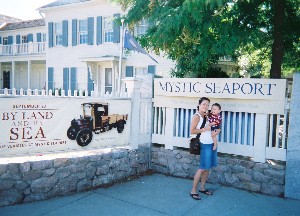
The Seaport – no one in the world calls it “The Museum of America and the Sea” – is HUGE. 17 acres huge. I’m confident saying it’s the largest museum in Connecticut. It’s Williamsburg for the sea-faring set. And it’s great. It helps that the weather was perfect for our visit since roughly 60% of the place is outside. I’ll steal the educational portion of my report from their website:
On December 29, 1929, Edward E. Bradley, an industrialist, Carl C. Cutler, a lawyer, and Dr. Charles K. Stillman, a physician, signed the papers incorporating the Marine Historical Association, today known as Mystic Seaport. Their dream: create a dynamic, educational institution to preserve America’s maritime culture and turn the achievements of a past era into an inspirational force for the future.
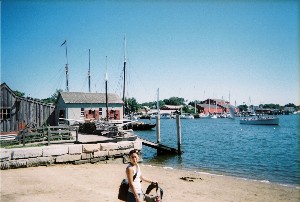
Despite the economic conditions of the Great Depression, Mystic Seaport grew rapidly. Donations of log books, photography, ships plans and other maritime artifacts poured into the one-building museum. In 1941, Mystic Seaport acquired the Charles W. Morgan, the country’s last wooden whaleship from the once-great Yankee fleet. Historic buildings from across New England were also moved in to complement the Morgan and the authentic coastal village area of Mystic Seaport was born.
Over the next 50 years, Mystic Seaport experienced explosive growth, amassing the world’s largest collections of maritime photography (over 1 million images) and boats (nearly 500), as well as collecting two million other maritime artifacts. And the 1970s saw the creation of the Henry B. duPont Preservation Shipyard, additional exhibition buildings and several new accredited educational programs. By the 1990s, Mystic Seaport was widely recognized as the nation’s leading maritime museum.
The Seaport is somewhat daunting, kind of like a Six Flags in that you don’t really know the best route to wander in order to take it all in efficiently. Hoang, ever the optimist, quipped at the outset, “What’s there to see here?”
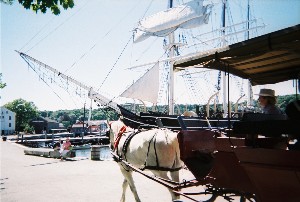
Um, EVERYTHING EVER COLLECTED ON EARTH EVER HAVING TO DO WITH MARITIME HISTORY? I shouted, loud enough for 30 people to hear. We’d already seen the museum store so we continued past and were confronted with several more stores. Hm, I thought, that’s not too exciting – even if the stores were “period” stores. We skipped them and then began hitting the “town.”
A one-room schoolhouse, the Fishtown Chapel; it’s important to note that these buildings are legit – most brought to the Seaport from nearby towns. In other words, if I had a need to pump up my museum count, this place is like 52 separate little museums. Take, for instance the “Children’s Museum” which we came upon after a few colonial homes replete with period furniture and informative displays.
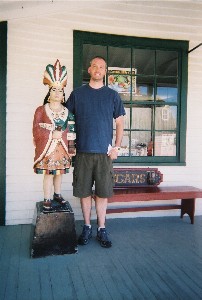
Damian enjoyed some of the old-timey toys like giant rope knots and “name that scurvy.” He then played on a few boats out in a courtyard and convinced us to skip the planetarium and another old house. After avoiding the horse-drawn carriage, we passed a live performance of college kids playing silly pirates and entered a full blown museum within the museum. “Voyages: Stories of America and the Sea.”
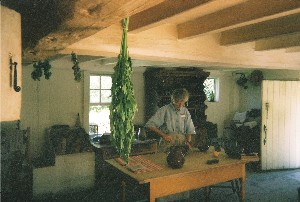
Wow. One could spend 90 minutes in this building alone; tracing America’s maritime history (from the European perspective) from the 1600’s through today. Photography was not allowed in there, but I took a few without the flash. The result was about 4 pitch black pictures of course. There was a whole floor dedicated to the history of shipping. Another large section devoted to our Naval history in which I learned what a Powder Monkey was.
(A Civil War era sailor in the rank of Boy whose job it was to keep gun crews supplied with gunpowder and shot during battle. At other times they served in other menial ways earning little more than a cot and food.)
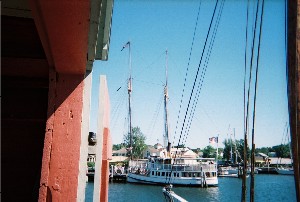
Yes… the rank of “Boy.” Anyway, there were lots of cool model ships, something authentic from David “Damn the torpedoes” Farragut, a live human carving scrimshaw, and an entire third floor dedicated to modern day aquaculture in and around the Long Island Sound. It was more or less the entire Connecticut River Museum here at the Seaport – where there happens to be a million other things to see.

Oh what’s next? Mallory Exhibit Hall? An entire art gallery impressive in its own right? With a massive room full of ship figureheads? And that gallery is right next to an entire church from the 1700’s which sits next to another large art gallery currently with an exhibit honoring African-American contributions to our maritime history? If you haven’t yet gathered, the Seaport is a massively impressive place.
Don’t believe me yet? Okay, skip the giant research library like everyone else (me included – but it needs to be noted that it contains over 100,000 ship plans) and make your way right over to the Benjamin F. Packard Ship cabin. That is, you can walk into an old sailing ship’s cabin and check out what life was like back in the day on the sea. Oh wait, the next building? Yeah, it’s only about 1000 square feet full of authentic small boats from the last 300 years or so. Heck, they even have an original Delaware Ducker!
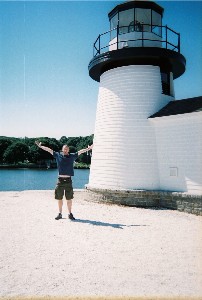
Now would be a good time to apologize again for the horrible pictures. Just had to say that.
We doubled back and grabbed refreshments at the old timey tavern and the modern ice-cream stand. From there, we explored the Charles W. Morgan tall ship. Why blow me down! It’s the last wooden whaleship in the world. It’s pretty cool, too; you can explore all over the ship, down a level into the bunk rooms and the galley. There were whale blubber rooms and supply rooms. I simply can not imagine living on that thing for months at a time out at sea.
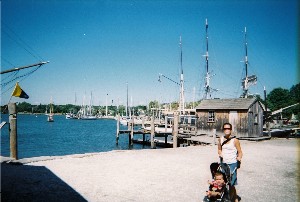
I know, I need to speed this along… After the ship, we checked out the following 18th and 19th century buildings complete with actors acting inside them: A bank, a drug store, a cooperage (barrell making), another house, a print shop with old working presses, a shipcarver’s shop, a hoop shop, and a nautical instrument shop which was really interesting. There were displays on how the old-timers made sextants and compasses and clocks and things of that nature. I could have spent an hour in there alone, but there was more!
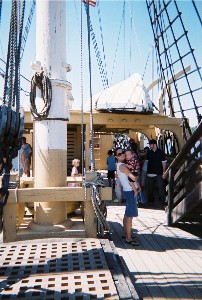
Like the Shipsmith shop – the only manufacturer of ironwork for the whaling industry known to have survived from the 19th century. Want to know more? And while you’re reading up on that, we’re off to the old clamshack which was next to the sail making factory building. At this point, you probably think I’m joking… I’m not.
Especially when I tell you that the next building was a 250 foot long monster, teaching visitors how rope was made in the early 19th century. Starting out as little strands and ending down the looooooooong line as a strong, thick rope, the process is fascinating to learn.
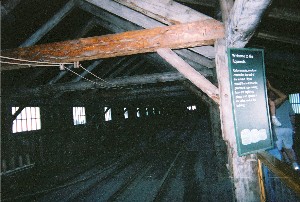
Let’s see… what else? Oh another small boat exhibit, a nice little lighthouse, a period salmon shack, a boat repair building showing us all the olden techniques, an oyster shack, a lobster shack, a huge scale model of the entire seaside town of Mystic – done in incredible detail. Oh look, an old running steamboat. Sigh. (I’m sighing from being overwhelmed, not out of boredom by any stretch!)
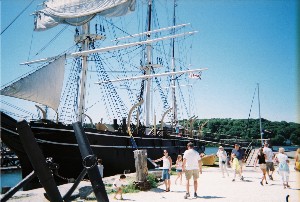
Believe it or not, there are a few more acres – dedicated to the art of ship building and preservation. We didn’t spend much time at all there, as Damian was at the end of his ropewalk. We took a few minutes to check out the three-floored, large, and very nice Maritime art gallery before we hit the road for home.
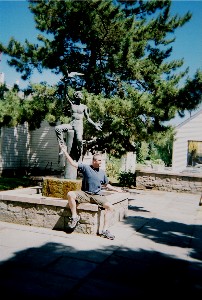
When we made our way into the Seaport a few hours prior, we were told our wristband was good for two days. At the time Hoang and I thought that was a bit wacky – now I know better – if we didn’t have a toddler in tow, we’d probably have spent another two hours there.
The Mystic Seaport rules.
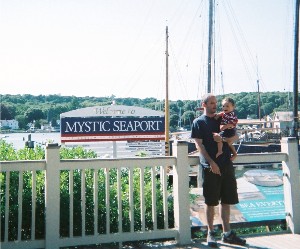
![]()
Mystic Seaport
CTMQ’s Museum Visits

 Catherine says
Catherine says
October 7, 2007 at 6:23 amThis was a really good write-up for a very cool place. My Dad absolutely loves this place!
 Radford says
Radford says
March 16, 2009 at 2:06 pmCommenting usually isnt my thing, but ive spent an hour on the site, so thanks for the info